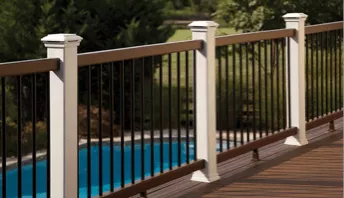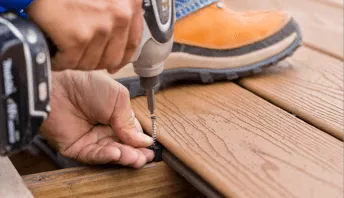As an Amazon Associate, Decks.com earns from qualifying purchases from the links in this post.
How to Seal Your Deck & Best Deck Sealers
Without a protective coating, exposure to extreme heat and cold can have a detrimental effect on the surface of your wooden deck. And while both sealing and staining serve the purpose of preserving and protecting your deck, sealing in particular offers some very specific benefits.
Deck Sealer
Deck sealer is typically a transparent coat that seeps deep into the wood and forms a clear film on the surface while maintaining the wood’s natural finish. By penetrating the wood, the sealer creates a protective layer that helps minimize water infiltration and lock out moisture. This preventative finish is crucial in reducing fungal growth and wood rot, both of which can shorten your deck’s lifespan. While deck sealer slows the effects of water damage, it does not protect well against harsh UV rays. Even with sealer, direct sunlight will eventually dry up the wood’s natural oils, cause fading and lead to cracking and splitting.
Deck Stain
Deck stain also provides water-resistant qualities, but also adds pigment to the wood in varying opacities, from semi-transparent to solid. Many stains come in a wide variety of tones to choose from, as well, allowing you to achieve a variety of finished colors. Because stains add pigment, they are better suited to block UV light and offer more protection than just a sealer. In fact, the darker the stain, the more pigment that is added, ultimately giving your deck more protection.
Applying Deck Sealer to a Wood Deck
To get the most effective seal possible, thoroughly clean your deck before applying the sealer. Be sure all debris, dust, grime and mildew is removed. Check out our step-by-step guide for the best ways to clean a deck or pressure wash a deck.
Before we get into the step-by-step details of how to seal a wood deck, there are a few things to keep in mind. For starters, don’t apply deck sealer in direct sunlight as the finish will dry too quickly. The sealer needs time to adequately absorb into the wood. Also, if you have a brand-new deck made with treated wood, it’s best to hold off a few weeks to allow the wood to completely dry so the stain is more fully absorbed. Now, you’re ready to begin!
Step 1: Check the forecast
The first step in applying deck sealer is to ensure that you’ve got at least two days of dry weather with temperatures between 50-90 °F. This will ensure the best seal.
Step 2: Clear the deck
It probably goes without saying, but you don’t want to start sealing your deck with furniture, plants and other furnishings scattered about.
Step 3: Sand (if needed)
Before sealing, you may need to sand your deck to ensure that the sealer penetrates the wood adequately. Sanding is time consuming but necessary in many cases. Grab a pole or palm sander to speed up the process, making sure you sand in the direction of the grain. Always wear a safety mask when sanding to avoid inhaling sawdust.
Step 4: Remove debris
After sanding, you’ll want to ensure that the entire deck is free of loose debris. That includes cleaning between the cracks and then making sure the deck is totally dry.
Step 5: Stir sealer
Before applying the sealer, make sure to stir it. DO NOT shake. Shaking may cause bubbles to form in the finish.
Step 6: Apply sealer
Using a brush, paint roller, or sprayer, apply a thin coat over a two-to-three-board section. You can always add another thin coat later as it will apply and dry better than one thick coat.
Back-rolling may also be necessary to create the best coat possible. This requires one person to apply the seal and another person to use a roller or broom to spread puddles and work the finish thoroughly into the wood.
Step 7: Repeat & fine tune
Repeat Step 6 for the entire deck. Use a finer paintbrush to apply the sealer in difficult areas, such as cracks, railings and steps.
Step 8: Let it dry
Allow the deck to dry completely before use.
Best Deck Sealers
Protecting your deck is a lot less expensive than building a new one, so don’t leave it exposed to the elements, which eventually leads to wear, rot and mildew. Take action early and often with quality deck stain and sealers to prolong your deck’s longevity.
But how do you know which are the best deck stains and sealers? Which ones can be trusted to withstand weather, wear and tear? Here are some of the best deck sealers on the market:
Thompsons Waterseal Advanced Natural Wood Protector
As one of the best water seal products available, Thompsons will go a long way to preserving your deck from mildew and water damage. It will also help with UV damage and color fading over the long term.
ECO-SAFE Wood Treatment – Stain & Preservation by Tall Earth
One of the great things about Tall Earth’s ECO-SAFE Wood Treatment is that it’s ready to use without any special pre-application prepping, as long as your deck is clean. One application is all that’s needed for protection; no need to apply multiple coats.
Rust-Oleum Coppercoat Wood Preservative
This EPA-registered deck sealer delivers all the benefits of a good sealer while also protecting your deck from termites and ants. You may notice a slight transparent green layer after application but it will fade with time.
CabotStain Australian Timber Oil Penetrating Oil
CabotStain is a high-quality sealer that will penetrate deep into even the densest types of wood, and unlike most other sealers, it can help prevent UV damage with iron oxide pigmentation.
Thompsons Waterseal – Transparent Stain
The best of both worlds, this deck stain and sealer combo provides a transparent color while creating a waterproof surface to prevent damage from mildew, rot and mold. It’s a user-friendly sealer that dries quickly after application.
This page contains affiliate links. If you choose to purchase after clicking a link, Decks.com may receive a commission at no extra cost to you.
Best Deck Cleaner Options
Discover the best deck cleaning and brightening solutions for composite decks, wood decks, and more. Learn how to remove dirt, mildew, and algae with Decks.com.
How to Bug-Proof Your Deck & Floorboards
Prevent bug infestations below and above your deck using mesh, screens, and more. Learn how you can have a bug-free deck this summer with Decks.com.
Capped Composite Decking
What is capped composite decking? It's a great option if you like the look of wood but not the maintenance. Learn about capped composite at Decks.com.
Types of Wood Decking Materials
There are many options for choosing the best wood for your deck, like pressure treated pine, cedar, redwood or mahogany. Compare types of wood at Decks.com.
Cedar Decking: Prices, Different Types, Maintenance & More
Cedar decking is an option if you want to build your deck from wood. Learn about the types, costs, and maintenance required for cedar decking at Decks.com.
More Helpful Resources
Explore Articles by Topic

Footings
Information related to installing frost footings for decks

Framing
Learn structural framing methods

Decking
Learn about wood and composite decking materials

Stairs
An in-depth look at the complex issue of how to build stairs

Railings
How to install guardrails and handrails to meet IRC code

Features
An overview on water drainage, benches, planters and lights

Design
The basics of deck design

Planning
Learn about permits and working with contractors

Porches & Patios
Build a covered deck to enjoy all seasons

Ledger
Proper attachment techniques

Care
Maintain your deck to maintain your investment

Materials
An overview on water drainage, benches, planters and lights
How to Remove Scuffs and Scratches from Composite Decking
Removing scuffs and scratches can help make your composite deck look like new. Learn how to fix and prevent your composite deck from future scratches.
Can You Paint or Stain Composite Decking?
Most composites don’t require painting or staining. However, if you are considering staining or painting your deck, you can learn how to do so and what you’ll need at Decks.com.
How to Stain a Wood Deck
Staining your deck, porch or patio can help maintain the longevity of its appearance. Learn how to stain your deck with these easy to follow steps at Decks.com.
Is Trex Decking Worth the Investment? Expert Insights and Reviews
Discover why Trex decking is worth the investment. Learn about its durability, low maintenance, eco-friendliness, and the long-term value it adds to your home.
How to Read Lumber Grade Stamping
Any lumber you purchase should have a grade stamp, which provides info about the characteristics of the wood. Learn how to read lumber stamps at Decks.com.
How to Dry & Treat Wet Wood
Wet wood shrinks as it dries out and becomes less stable, which can cause it to check and warp. Learn how to dry out and treat wet wood at Decks.com.
Explore Articles by Topic

Footings
Information related to installing frost footings for decks

Framing
Learn structural framing methods

Decking
Learn about wood and composite decking materials

Stairs
An in-depth look at the complex issue of how to build stairs

Railings
How to install guardrails and handrails to meet IRC code

Features
An overview on water drainage, benches, planters and lights

Design
The basics of deck design

Planning
Learn about permits and working with contractors

Porches & Patios
Build a covered deck to enjoy all seasons

Ledger
Proper attachment techniques

Care
Maintain your deck to maintain your investment

Materials
An overview on water drainage, benches, planters and lights


















